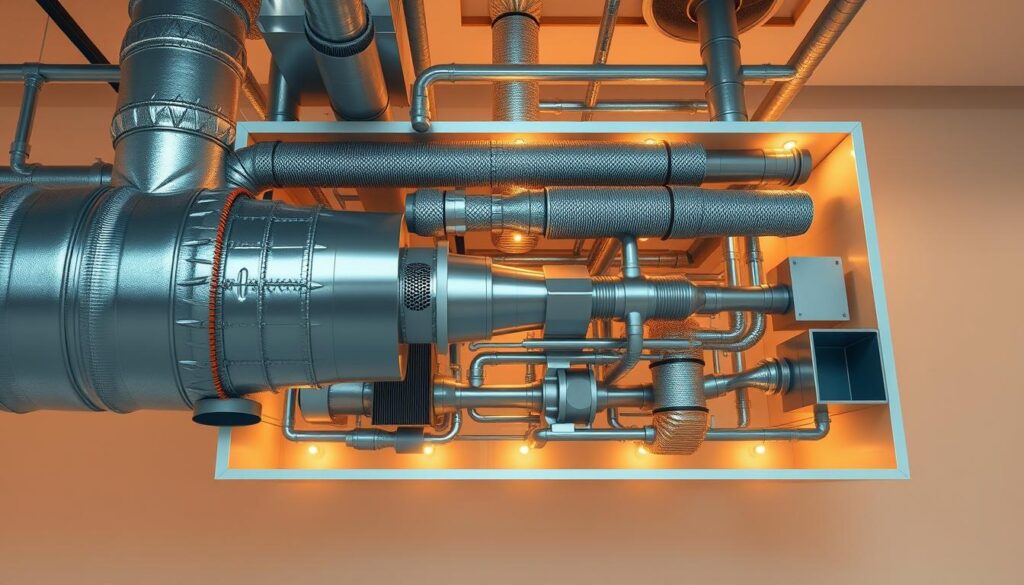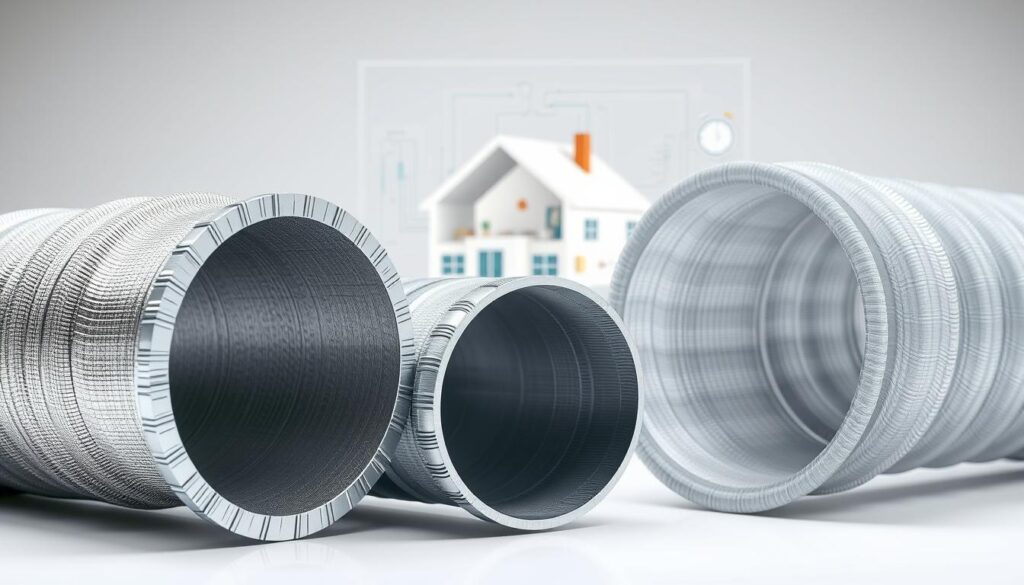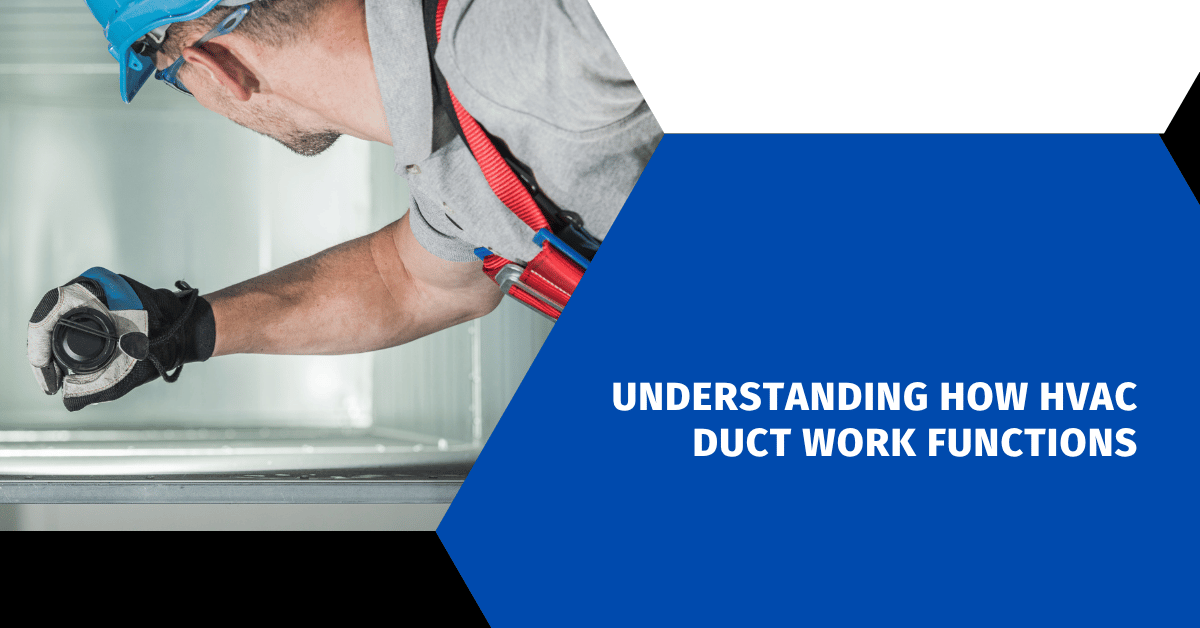Affiliate Disclosure
HVAC Guide Guys is a participant in the Amazon Services LLC Associates Program, an affiliate advertising program designed to provide a means for sites to earn advertising fees by advertising and linking to Amazon.
Understanding How HVAC Duct Work Functions? Ever wondered how your home stays perfectly cool or warm, no matter the weather? It’s all thanks to the hidden world of HVAC ductwork. This complex network quietly keeps your home comfortable.

HVAC ductwork is more than just metal tubes. It’s the heart of your home’s heating, ventilation, and air conditioning. These paths spread out conditioned air, making sure you’re always comfortable and breathing clean air.
Today’s HVAC systems are like high-tech tools. They’re essential in both homes and offices. They control the temperature and air quality, making spaces healthier to live and work in.
Many people don’t realize how vital their ductwork is. A bad duct system can waste up to 30% of your heating and cooling energy. Knowing about your ductwork can help you save energy and make your home more comfortable.
Key Takeaways
- HVAC ductwork is the critical infrastructure for air distribution
- Proper installation impacts energy efficiency and comfort
- Duct systems filter and circulate indoor air
- Regular maintenance prevents energy waste
- Well-designed ductwork can improve indoor air quality
Table of Contents
What Is HVAC Ductwork and Its Purpose
HVAC ductwork is the heart of your home’s climate control. It’s like a highway for air, keeping your space comfy and the air clean. The design of your ductwork is key to a healthy, efficient home.
Ductwork does more than just move air. It’s vital for your home’s comfort and energy use.
Basic Components of HVAC Systems
An HVAC system has important parts for air flow:
- Supply ducts: Carry cool or warm air to rooms
- Return ducts: Bring air back for cooling or heating
- Plenums: Big boxes that connect ducts
- Air handlers: Move and change the air’s temperature
Role in Home Comfort and Air Quality
The size of your ducts affects your home’s comfort. Good duct design means:
- Even temperatures in every room
- Less dust and allergens in the air
- Just the right humidity
Energy Efficiency Considerations
Good ductwork saves energy. Here are some facts:
- Up to 30% energy loss with bad insulation
- Sealing ducts well boosts system efficiency
- Regular care makes ducts last longer (15-25 years)
“Ductwork is the circulatory system of your home’s climate control” – HVAC Professionals
Quality duct design and sizing lead to better performance, comfort, and savings. This is true for homes and offices alike.
Essential Components of HVAC Duct Systems
Knowing the key parts of HVAC duct systems is vital for keeping your home comfy and air clean. Your HVAC system has many parts that work together. They help spread cooled or heated air all over your home.
- Supply and return ducts
- Plenums
- Air handlers
- Refrigerant lines
- Drain pans
Different materials for HVAC ducts affect how well they work. Galvanized steel is the top pick, used in about 70% of ductwork. Aluminum is lighter and makes installation 30% quicker than other materials.
Choosing the right hvac duct accessories can dramatically improve your system’s efficiency and longevity.
Each key component has its own job:
| Component | Primary Function | Performance Impact |
|---|---|---|
| Plenums | Air distribution hub | Handles up to 1,200 CFM |
| Air Handlers | Circulate conditioned air | Critical for system efficiency |
| Turning Vanes | Reduce air turbulence | Decrease turbulence by 60% |
Keeping your HVAC system in good shape is key. With the right care, these systems can last 10-15 years. So, it’s important for homeowners to know about their parts.
Explore Our HVAC Shop
Looking for top-rated HVAC tools, parts, and accessories? Visit our shop and find the perfect solution for your needs.
Visit the ShopHow HVAC Duct Work Functions in Your Home
It’s important to know how your home’s HVAC system works. It’s like a network that moves and changes air in your home. This keeps your indoor space comfortable.
Air Distribution Process
The air distribution process has a few key steps:
- Air intake through return ducts
- Filtration of incoming air
- Heating or cooling by the central unit
- Redistribution through supply ducts
Temperature Control Mechanisms
Temperature control is complex. Your thermostat tells the HVAC system when to heat or cool. Dampers in the ducts help control airflow to different areas.
“Efficient HVAC systems can reduce energy costs by up to 30% through smart design and proper maintenance.”
Ventilation Principles
Good ventilation is key for clean air inside. HVAC systems have parts that:
- Remove stale air
- Bring in fresh air
- Manage humidity
- Filter out pollutants
Did you know? About 90% of air in your home goes through return ducts. It gets filtered and changed before it’s sent back out.
Main Types of HVAC Ductwork Materials

Choosing the right HVAC duct materials is key for your home’s comfort and energy use. Each material has its own benefits for your air system.
Sheet metal is the top choice for rigid air ducts. It’s usually made from galvanized steel or aluminum. These ducts are durable and keep the air clean. Aluminum is popular because it’s light and easy to put in place.
- Galvanized Steel: Traditional and robust material
- Aluminum: Lightweight and corrosion-resistant
- Stainless Steel: Growing in residential applications
Flexible ducts have their own perks when compared to rigid ones. They are:
- Low upfront cost
- Lightweight design
- Easy to install in tight spaces
“Not all duct materials are created equal. Your choice impacts air quality, energy efficiency, and long-term performance.” – HVAC Experts
Fiberboard is another option. It’s cost-effective and self-insulated, making it a good choice. It’s also good against rodents and keeps the temperature right. But, it can get wet and grow mold.
Your home’s layout, budget, and air quality needs will guide your choice. Getting advice from a pro can help you decide best.
Explore Our HVAC Shop
Looking for top-rated HVAC tools, parts, and accessories? Visit our shop and find the perfect solution for your needs.
Visit the ShopUnderstanding Supply and Return Air Flow
Your HVAC system works best when supply and return air flow are balanced. This balance is key to keeping your home comfortable and the air clean.
The system has two main parts: supply and return air ducts. These ducts work together to keep your home comfortable and clean.
Supply Duct Operation
Supply ducts send cooled or heated air to your home’s rooms. They:
- Distribute air from your HVAC system
- Keep temperatures even in all rooms
- Use accessories like registers to control air flow
Return Duct Functionality
Return air vents are vital for your HVAC system. They:
- Draw air back to the system with a slight suction
- Filter out allergens and pollutants
- Help keep air pressure balanced
Airflow Balance Importance
Balanced airflow is the secret to an efficient HVAC system.
| Airflow Metric | Recommended Standard |
|---|---|
| Airflow Measurement | Cubic Feet per Minute (CFM) |
| Ideal CFM Balance | Input = Output |
| Potential Efficiency Loss | Up to 15% with Imbalanced Systems |
Keeping airflow balanced is essential. It prevents issues like uneven temperatures and higher energy use. Regular maintenance keeps your HVAC system running smoothly.
Common HVAC Ductwork Design Configurations
Designing the right HVAC duct system is key for comfort and saving energy at home. Your system’s performance depends on the ductwork you choose. It must fit your space perfectly.
- Radial System
- Reducing Trunk System
- Extended Plenum System
- Perimeter Loop System
Choosing the right design means knowing your building’s layout and duct sizing needs. Each design has its own benefits for different spaces.
| Configuration | Best Suited For | Airflow Efficiency |
|---|---|---|
| Radial System | Smaller residential spaces | Good (1400-1800 CFM) |
| Reducing Trunk System | Multi-level buildings | Moderate (1200-1500 CFM) |
| Extended Plenum System | Large commercial spaces | High (1800-2000 CFM) |
| Perimeter Loop System | Buildings with consistent layout | Very Good (1480-1875 CFM) |
“Proper duct design can reduce energy costs by up to 20% and improve overall system performance.”
When designing your ductwork, think about air velocity, leakage points, and system resistance. Wrongly sized ducts can cause noise, lower efficiency, and raise energy use.
Getting advice from HVAC experts helps pick the best design for your home or business.
Explore Our HVAC Shop
Looking for top-rated HVAC tools, parts, and accessories? Visit our shop and find the perfect solution for your needs.
Visit the ShopHVAC Ductwork Installation Requirements
Installing HVAC ductwork is a key process that needs precision and expertise. Your home’s comfort and energy use depend on a good duct system.
Professional hvac ductwork installation is about more than just putting ducts in place. It’s about making sure your heating and cooling system works well and lasts long.
Professional Installation Standards
Professionals follow strict rules for hvac duct insulation and installation. This ensures your system works at its best:
- They figure out the exact air needs for each room
- They design ducts with few turns for better airflow
- They use the right sealing materials like metal-backed tape or mastic
- They make sure supply and return ducts are the right size
Building Code Compliance
Following local building codes is key for safe and effective ductwork installation. Important rules include:
- Keeping double-wall flue pipes at the right distance
- Putting return vents in the best spots
- Choosing the right size for registers and grilles
Safety Considerations
Safety is top priority during hvac ductwork installation. Homeowners should focus on:
- Choosing licensed HVAC technicians
- Ensuring good ventilation
- Wearing the right protective gear
Proper ductwork installation can cut energy costs by up to 30% and boost system efficiency.
| Installation Aspect | Recommended Standard |
|---|---|
| Plenum Duct Size | 17.5 x 20 inches |
| Branch Duct Diameter | Approximately 5 inches |
| Return Vents per Home | 3-4 good-sized returns |
| Installation Cost Range | $1,200 – $5,000 |
Remember, investing in professional HVAC ductwork installation pays off through improved comfort, energy efficiency, and long-term system performance.
Signs of Ductwork Problems and Maintenance Needs

Your home’s HVAC system sends out subtle signals when something’s amiss with the ductwork. Spotting these signs early can prevent expensive repairs and keep your air clean.
Look out for these important signs that your ductwork needs help:
- Uneven room temperatures hint at airflow problems
- Unexpected jumps in your energy bills
- Too much dust around your vents
- Strange noises like whistling or rattling from the ducts
- Musty or moldy smells when the system is on
The U.S. Department of Energy says up to 30% of HVAC energy can be lost through bad ductwork. This big loss affects your bills and comfort at home.
“Regular hvac duct cleaning is not just maintenance—it’s an investment in your home’s health and efficiency.”
Here are some important maintenance tips:
- Get professional duct inspections every year
- Change air filters every 1-2 months
- Look for leaks or damage
- Get ducts cleaned by pros every 3-5 years
If you keep getting sick or have allergies without reason, it might mean your ductwork is faulty. You’ll need a pro to fix it.
Energy Efficiency and Ductwork Performance
Your HVAC system’s efficiency depends a lot on your ductwork. Proper insulation can cut down energy waste and make your home more comfortable.
Experts say energy loss through ducts can be 25% to 40% of heating or cooling energy. This shows how important it is to know how ductwork affects your home’s energy use.
Insulation Requirements
Effective duct insulation needs careful thought:
- Choose insulation with the right R-value for your area
- Make sure all duct surfaces are covered
- Use materials that can handle moisture and temperature changes
Sealing and Leakage Prevention
Stopping air leaks is key to keeping your HVAC efficient. Leaky ducts can raise energy costs by 20-30%, so sealing is vital.
“A well-sealed duct system can reduce your energy consumption and improve overall home comfort.” – HVAC Efficiency Experts
Here are ways to stop duct leaks:
- Use mastic sealant for lasting connections
- Apply metal-backed tape on joints
- Get regular checks from professionals
By using these methods, you can cut energy needs by up to 20% and lower your bills a lot.
Explore Our HVAC Shop
Looking for top-rated HVAC tools, parts, and accessories? Visit our shop and find the perfect solution for your needs.
Visit the ShopProfessional Ductwork Services and Repairs
Keeping your home’s HVAC system in top shape is key. Services like hvac duct repair and cleaning are essential. They help keep your home comfortable and the air clean. Experts have the skills to tackle tough ductwork problems.
When do you need professional ductwork help? Look out for these signs:
- Uneven heating or cooling in your home
- High energy bills without reason
- Dust near air vents
- Less air coming from vents
- Strange sounds from your ducts
Professional HVAC techs can fix these issues with their services:
| Service Type | Key Benefits |
|---|---|
| Duct Cleaning | Removes dust, allergens, and mold |
| Duct Repair | Fixes leaks and damage |
| System Inspection | Finds performance problems |
| Efficiency Optimization | Makes your HVAC system work better |
“Regular professional maintenance can extend your HVAC system’s lifespan and improve indoor air quality.” – HVAC Industry Expert
Choosing the right HVAC pro means picking someone with EPA certification and lots of experience. Look for 24/7 emergency services and clear pricing. This ensures your home’s comfort is always a top priority.
Conclusion
Knowing how HVAC duct work works is key to a comfy and energy-saving home. The right HVAC ductwork installation is vital for the best system performance. With ratings up to 25 SEER, keeping it in good shape can save you money and keep your home cozy.
Keeping your ducted HVAC system in top shape is important. Experts say to clean air ducts every three to five years to keep things running smoothly. Dirty ducts can cut system efficiency by 20%, raising your bills and possibly harming air quality. Professional air duct cleaning can boost your indoor air and help with allergies and breathing problems.
Zone control and smart HVAC ductwork can save you energy. Modern systems let you adjust temperatures in different areas, saving energy. A well-kept system can last over 10 years, making your initial investment worth it for comfort and energy savings.
Start taking care of your HVAC system today. Talk to professional HVAC technicians for advice on ductwork care, cleaning, and upgrades. Regular maintenance will make your home healthier, more comfortable, and save on energy costs.

